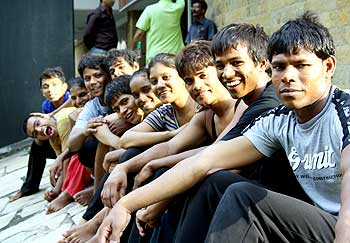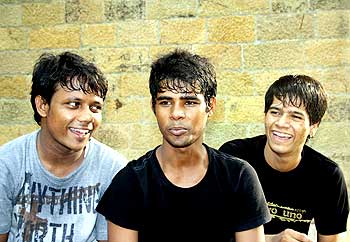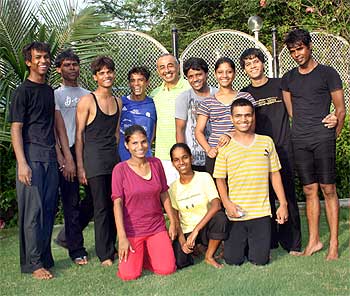Choreographer Astad Deboo pushes 13 kids, who have lived of the streets and have no prior dance experience, to the limits of their prowess in the five-act dance performance 'Breaking Boundaries'.
At the dimly-lit experimental theatre in Mumbai's prestigious National Centre for Performing Arts, a group of 13 dancers, positioned precariously on four narrow benches, focus the last drop of their concentration and strength on maintaining their balance.
As the somber music picks up, the dancers gingerly unfold their taut limbs, and metamorphose into the next complicated step of the dance rehearsal. A group of boys, hitherto motionless on a bench at the back of the stage, uncoil like a group of overdriven springs and jump down and back up again in a seamless motion, and continue doing so.
The sparse audience, comprising choreographers, light operators, music controllers and NCPA employees, collectively hold their breath, anticipating an impending misstep and the resultant crash that, surprisingly, never happens.
This routine of 'dancing in contained spaces; dancing in, on and around benches' as choreographer Astad Deboo puts it, forms part of the five-act 'Breaking Boundaries', a dance performance that premiered at the NCPA, Mumbai on October 1.
The nearly-impossible steps, which raise the possibility of breaking the concerned benches and the dancers' bones, rather than boundaries, are practiced over and over again by the 13 dancers, under Deboo's watchful eyes. These dancers form an interesting bunch -- they comprise actors, dancers, footballers and even a puppeteer.
What is impossible to glean from the near perfection of their dance steps is the fact that these children and young adults -- the youngest is 13 and the oldest 24 -- have all lived on the streets at some point in their lives. They are former or present members of the Salaam Balak Trust, a non-governmental organisation that works with orphaned or abandoned children, and before they joined Deboo's workshop in October 2008, they have never had any formal training in dance.
Text: Sanchari Bhattacharya. Video & Photographs: Reuben N V

Says Deboo, "They only knew Bollywood dance. It took a long time for them to learn. They had to learn the notions of synchronisation, harmony, confidence, fliexibility -- how much you can push your body. They learnt the nuances of contemporary dance, the minimalism, the introduction of the Mudras."
For many of the dancers, it is their first trip to Mumbai, the Mayanagari where "we have come to see the stars," inform the younger dancers. "Yes, right, we will catch some stars for you here," quip the older ones.
They are excited about their visit, but they admit that they haven't really had the time and opportunity to go sight-seeing, though they are confident of doing so once the performances, on three consecutive nights, are done.
But for now, they have no time for distractions as Deboo, known for being a tough taskmaster, tries to familiarise them with the dimensions and feel of the NCPA stage.
Mohammad Shamsur, 24, one of the best dancers in the group and its self-appointed spokesperson, defends the tough training schedule. "One has to be strict, varna toh Lagaan aur Gadar ho jaati hai. It is only when you face intense pressure that you work hard, listen more."
And he is right. Rigorous training sessions with the ace dancer between January and April had culminated in the group's first performance in April this year at the Kamani Auditorium, New Delhi.
The widely acclaimed performance was attended by Delhi Chief Minister Sheila Dikshit, diplomats, bureaucrats, and the babu types, recalls Deboo, adding with a tinge of regret,"There was a long queue of people waiting for a chance to get in. We couldn't even accommodate some 150 kids who wanted to watch the show."
Rekha, the youngest member of the group at 13, admits that the rehearsals are difficult, but adds, "Sometimes, during rehearsals, I feel that I can't go on anymore, but after the performance, I feel that the dancing has to go on."
In the same breath, she narrates how she ran away from home at the age of 10, and boarded a train to Delhi from her native place in Maharashtra, as "my friends told me Delhi is a nice place".
A kind stranger, who saw her crying and begging for food at the Delhi railway station, took her to the nearest SBT shelter, where she has been living ever since.
All the dancers have similar stories; they fled their homes, driven out by poverty or abuse, or got separated from their parents at a young age.

Pankaj, 20, an aspiring actor, used to work in a bangle factory in Ferozabad, Uttar Pradesh, when he decided to leave home. The SBT not only rescued him from the Delhi streets, but the NGO also encouraged his passion for acting. Pankaj has acted in the Abhay Deol-starrer Oye Lucky and the TV serial Jasoos Vijay. He is also actively involved in street theatre and hopes that, "The sense of movement that I learn from dancing will help me in my field."
Another aspiring actor is Saleem Zaidi, 17, who has acted in short films including The Forest and Little Terrorist. He was separated from his parents during a Muharram procession at the age of five. He did find his parents two years later, but preferred to stay on at the SBT.
It wasn't, and the subsequent training has not been easy for them, in spite of their familiarity with strenuous physical exercises. "Nasein dab jaati thi (It used to hurt our veins). Par abhi to body khul gayi hai. Lagta hai kuch bhi kar sakte hai.(Now our body has opened up. We feel like we can do anything)," says Thapa.
Viraj, 26, left his home in Jamshedpur when he was only six years old. "I wanted to study, and my mother couldn't afford that," he explains. He worked as a rag picker for a couple of months before he was spotted by a teacher from the SBT and brought to their shelter.
The dance movements, in which each dancer has to take the cue for the next step from the dancer in front of him/her, has also inculcated a sense of unique camaraderie and "now we treat each other with respect," says 17-year-old Gagan.
And for some of them, dancing in front of a live audience gives them much-needed confidence, which will eventually help them pursue their individual goals. "I never thought I could do even one show. And I am about to do my third show with Sir," says Anil Kumar, 21, a puppeteer, with a note of wonder.

So what is the next step for these youngsters? During a break in the rehearsal, Deboo talks about the difficulties in finding sponsors for such events. He had to start from scratch to garner funding for the Mumbai leg of the performance, after the corporate sponsors of the Delhi event backed out. But he still has grand plans for his motley troupe of SBT dancers.
He is planning a joint performance, with the SBT youngsters and Manipuri dancers, during the Golden Jubilee Celebrations of IIT- Kanpur in December.
Soon, Deboo and the group of dancers disappear back into the dark auditorium for another round of intense rehearsals, to synchronise and fine-tune their steps for another grand performance, to win another round of thunderous applause.
As Rekha, who dreams of becoming an air hostess some day, sums it up, "When people get up and clap, himmat aa jaati hai (I get the courage to go on), the pain disappears, lagta hai, thoda aur hona chahiye (I feel like I want more of it)".